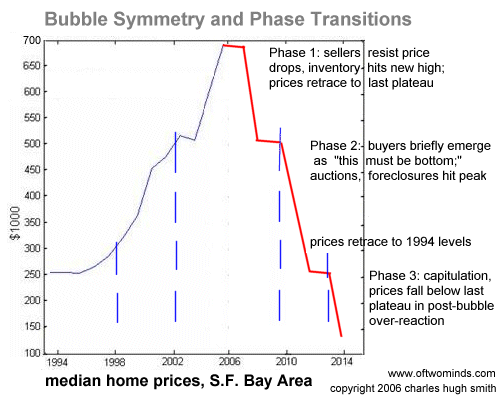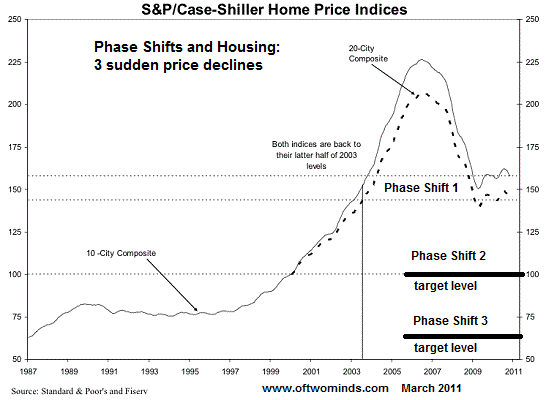Phase Shift: The Next Leg Down in House Prices
Housing has supposedly "hit bottom." Perhaps it will drop abruptly in a phase shift to much lower valuations. Way back in August 2006, near the top of the housing bubble, I suggested a two-part scenario for the housing bust: it would take eight more years to play out, and the declines would occur in sharp downlegs following a phase-shift model. Phase Transitions, Symmetry and Post-Bubble Declines (August 2, 2006) Here is the chart I presented at that time as a possible time model: A few months later, literally at the top of the housing bubble in early 2007, I suggested that a mere 4% of homeowners defaulting could trigger a collapse of the entire U.S. housing market. That is pretty much exactly what happened, for when the 4% who couldn't pay their subprime mortgages folded, they took down an exquisitely corrupt and vulnerable banking sector and the FIRE (finance, insurance, real estate) economy which had come to depend on it. Can 4% of Homeowners Sink the Entire Market? (February 21, 2007) As I noted in Phase Shifts, Stick/Slip and the Demise of Our "Socialist" Housing Policy(February 26, 2010), the "recovery" in housing visible in the chart below was entirely the result of a 99% "socialist" Central State intervention/prop job: the Federal Reserve bought $1.1 trillion of dodgy mortgages to mask the bad debt and keep interest rates low, and the Federal government flooded the housing market with fee money via subsidies and absurdly cheap, central State-guaranteed FHA loans. Now that this massive Central State intervention has ended, housing sales and values are succumbing to gravity. home sales and prices fall: Nearly 40 percent of the sales last month were either foreclosures or short sales, when the seller accepts less than they owe on the mortgage. One-third of all sales were purchased in cash - twice the rate from a year ago. In troubled housing markets such as Las Vegas and Miami, cash deals represent about half of sales. The median sales price fell 5.2 percent to $156,100, the lowest level since April 2002. Sales of new homes tumbled 16.9% in February from the prior month to a seasonally adjusted annual rate of 250,000, the lowest level since the series began in 1963. The median price for a new home sold in February fell 13.9% from the prior month to $202,100, the lowest since December 2003. Here we see the first phase shift decline and the "recovery," which is now rolling over. I submit that the forces acting on price are mutually reinforcing to the point that price will drop rapidly in a second phase shift, with the target noted on the chart: a return to the price levels of 2000. Once we get into the 2012-14 timeframe, then I expect a third phase shift will drop prices back to 1987 levels. As many observers have noted, bubbles don't retrace to historical averages--they over-correct to extremely low values. What forces are working to push housing prices to new lows? 1. As I reported on Daily Finance, new mortgage broker compensation rules are about to wipe out independent, small mortgage originators and brokers. Mortgages will probably become harder to come by and more expensive as the "too big to fail" banks will consolidate their grasp on the mortgage market. 2. Interest rates will rise. Most financial analysts are supremely confident that the Fed can keep interest rates near-zero forever. I suspect their confidence is misplaced. As I discussed yesterday, the Fed has backed itself into a corner, where if it pursues QE3 then it will fire up inflation that will destroy profit margins and household purchasing power. If it ceases to buy U.S. Treasury debt, then interest rates will shoot up. As interest rates rise, the amount of money home buyers can borrow drops. House prices follow this dynamic. 3. Income for the bottom 90% is stagnant. All the bogus "housing is now affordable again" charts floating around all base their rosy conclusions on median income, neatly avoiding the reality that the top 10% has garnered the majority of income gains. Factor out the top 10% and you find real incomes have actually declined for the lower 90%. The same effect is true of the "wealth effect" powered by the speculative risk trade bubbles in stocks and commodities. These portfolio increases have only enriched the top 10% who own the vast majority of the financial wealth. So yes, real estate favored by this top 10%--Manhattan, Westwood, San Francisco, etc.-- will hold its own as those benefiting from fat Federal contracts, Wall Street's renewed license to practice piracy, the bubble in lighter-than-air Web 2.0 stocks, etc. try to outbid each other, but for most housing, the support created by demand has just melted like dirty ice on a hot Spring day. 4. There are too many houses and not many buyers. The demographics are this: Baby Boomers are trying to sell to cash out or move, and the impoverished generations behind them cannot afford bubble-era prices. Just because prices have retreated to 2002 levels doesn't mean they're cheap--2002 was already a bubble, as you can see in the chart. 5. The Federal-supported "recovery" is in trouble, politically and financially. As long as the nation obeys the whip of the Fed and allows it to print $1 trillion to buy Treasury debt every year, then the travesty of a mockery of a sham can continue. But as I noted yesterday, this policy is destroying the dollar and the purchasing power of households. That game cannot run for long without political pushback. Saving the "too big to fail" banks and the Financial Plutocracy might be Item #1 on the Fed's list, but it ranks decidedly lower on voters' agendas. 6. Every investor who bought with cash because "this is the bottom" will 1) be underwater and anxious to sell and 2) be out of cash, having bet their capital playing "catch the falling knife" with real estate valuations. Sorry, cash buyers: the knife is still falling. Of Two Minds is also available via Kindle: Of Two Minds blog-Kindle
The National Association of Realtors said Monday that sales of previously occupied homes fell last month to a seasonally adjusted annual rate of 4.88 million. That's down 9.6 percent from 5.4 million in January. The pace is far below the 6 million homes a year that economists say represents a healthy market.

If you would like to post a comment, please go to DailyJava.net.
Order Survival+: Structuring Prosperity for Yourself and the Nation (free bits) (Mobi ebook) (Kindle) or Survival+ The Primer (Kindle) or Weblogs & New Media: Marketing in Crisis (free bits) (Kindle) or from your local bookseller.Thank you, Russell J. ($75), for your outstandingly generous contribution to this site-- I am greatly honored by your support and readership. Thank you, Kevin L. ($10/mo), for your outrageously generous subscription and longstanding contributions to this site -- I am greatly honored by your support and readership.























